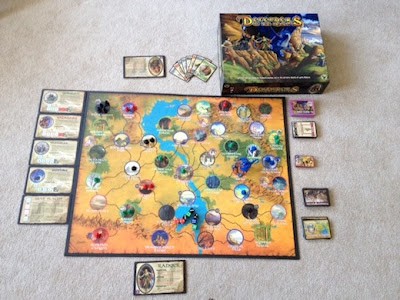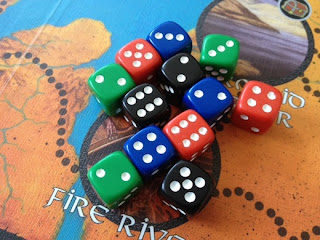One game that I've been really excited to try out (and finally received a copy of!) is Revolver. (Sorry, no Amazon link yet - I may go back and add it later.) I love Bang!, and so the theme of Revolver really appealed to me.
In Revolver, one player takes on the role of the Colty gang - who, led by Jack "The Crow" Colty, has just robbed a bank. Along with his 15 other gang members, Jack is now trying to catch the 3:15 train to escape. The other player takes on the role of Colonel McReady, who is trying to help bring the gang to justice - Wild West Justice (so, you're trying to kill them all). The game progresses through a series of battlefields, and to start each turn, the Colty player will advance the turn marker to indicate how close he is to escaping to the next battlefield (and ultimately to escape on the train). Next, on either player's turn, the active player draws two cards and then plays as many cards as they want from their hand. Some of these cards will go to a battlefield, where the McReady player is trying to shoot the members of the gang, and the Colty player is trying to shoot back and take cover in order to stay alive. At the end of the McReady player's turn, the Colonel will attack the Colty gang. Players will compare their fighting total, and if the Colonel wins, he kills one of the gang members. And, if the Colonel does not successfully kill any gang members on his turn, then they get a bit closer to escaping to Mexico (you remove a token from the "Mexico Border") card. Play continues like this until either Jack "The Crow" Colty has been killed, he has escaped on the 3:15 train (he survives until the end of the train battlefield), or his gang has escaped to Mexico (all of the tokens were removed from the Mexico Border card).
 |
| The "bad" guy |
The next pro, and truly the main strategic choice in the game, lies in balancing when to play various cards. Because the pursuit changes locations, setting up an ambush for the Colty gang cannot happen all at once. If you put all of your deputies in a single location, then you'll definitely kill some Colty gang members there - but once they escape that location, you won't be able to continue your pursuit! Essentially, each battleground has a certain number of turns that you will be there (which can go up or down based on cards). Especially around the last turn of each battleground, both players have to weigh the value of playing a lot of extra cards at a location - it will help them win the next fight, but then those cards will be stranded at that location and unable to move!
With those pros listed, there were also a few cons with Revolver. The first one is simply that certain things aren't especially clear. For example, the cards have small icons in the bottom left corner that say things like "Action," "Character," and "Firepower". Yet, some Action cards appear to work the same as the Character and Firepower cards - by being played and staying at the location. Yet, one of the rules is that "The Colty Gang has a three card limit. This means he can only play a maximum of three firepower cards at each battlefield. Once three cards have been placed by the Colty Gang player, he may not place any more cards at that battlefield..." (I added the italics.) So, how do Action cards fit into this? One specific action card is the "Gatling Gun." This Action is very powerful. Does it being an Action imply that it goes away after a time? This doesn't fit well with the rest of the rules, however. I have looked through the rules repeatedly and also looked through the official FAQ, and I haven't found the answer to what these symbols mean.
 |
| If he's good, why's he killing 16 people? |
The next con to Revolver is that the winner truly seems to be determined by the luck of the draw. Both players have some pretty useful cards, and whoever draws more of these powerful cards will probably win. The McReady player has several cards that let him instantly kill bandits - if he draws several of these early in the game, then there is very little that the Colty player can do. Yet, the Colty player has three cards that let him move through a battlefield more quickly. If he is able to get all of these (along with some of his other more valuable cards), he might be able to rush through the game and get the victory. But, though there is some strategy in determining what to play, and where to play it, there is a lot of luck involved in who can draw better cards.
The next couple of things I will mention aren't pros or cons, but are things to be aware of. First, I am not sure if the game is balanced. Now, I have played it a few times, but not nearly enough to say with any certainty whether it is balanced or not. In addition, I have seen both sides win, so I know that it is possible. Yet, it still seems like the game is skewed in favor of the Colonel McReady player. He has so many cards that let him instantly kill bandits, that it is very hard to stop him from killing the gang. In addition, he also has significantly more cards that let him draw an extra card (which is really a bonus in itself), and also has a couple that let him keep the Colty player at a battlefield longer. Again, I don't know this for certain, but it at least gives me the feel that the McReady player has an advantage - if you've played the game a few times, I'd love to hear in the comments whether you have the same thoughts on the balance of the game.
Finally, the cards have black borders, and they show wear incredibly quickly. I actually noticed that my copy was showing wear during the first game. If you are a person that likes to put sleeves on your games in order to keep them pristine, you will want to have your sleeves ready before you start playing. I don't think that any of the cards are showing wear to the point that either of my decks is marked, but I was still a bit disappointed that before I finished my first game, it looked like I had played the game dozens of times.
Overall, I give Revolver a 7.5/10. I enjoyed the theme, and I think that the game is fun to play, yet I think that the game is luck driven enough that I probably will not play it too often - just occasionally as a nice, light, change of pace.
If you like Revolver, you might also check out my reviews of Bang! (of course), Wyatt Earp, and Gubs (if you have kids).
I would like to thank Stronghold Games for providing me with a review copy of Revolver.






















